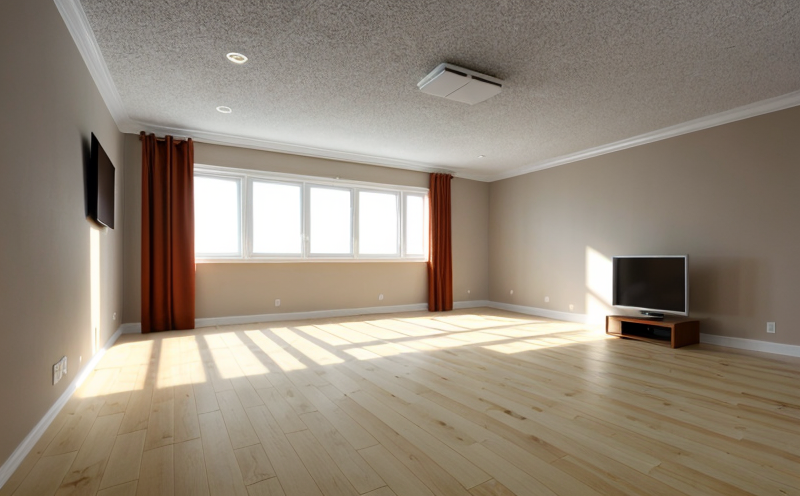ASTM E492 Laboratory Measurement of Impact Sound Insulation
The ASTM E492 standard provides a comprehensive method to measure impact sound insulation in laboratory conditions. This test is crucial for ensuring the performance of materials and systems that are intended to reduce noise transmission between rooms or spaces, such as floors, ceilings, and partitions.
Impact sound testing evaluates how well a structure can prevent the transmission of impact sounds from one room to another. This type of sound insulation is often found in residential buildings, commercial properties, and public spaces where privacy and quiet are essential. The ASTM E492 test specifically targets the measurement of impact noise that occurs due to foot traffic or other similar activities.
The methodology involves placing a source plate on one side of a partition and recording the sound level at a receiver plate on the opposite side. A standardized tapping machine is used to produce impact sounds, which are then measured using microphones placed around the receiving room. The test aims to quantify the reduction in sound energy that passes through the partition.
The results of this testing provide critical data for quality managers and compliance officers who need to ensure their products meet regulatory requirements or exceed customer expectations. For R&D engineers, ASTM E492 offers a robust framework for developing and optimizing materials and designs aimed at improving sound insulation performance. Procurement professionals can use the outcomes from these tests to select suppliers of high-quality materials that meet stringent noise control standards.
The ASTM E492 test is particularly important in environments where privacy and tranquility are paramount, such as hospitals, schools, offices, and residential complexes. By adhering to this standard, architects, engineers, and builders can ensure that their projects comply with local building codes and regulations designed to promote a healthier indoor environment.
One of the key benefits of ASTM E492 is its ability to provide precise data on sound insulation performance under controlled conditions. This enables stakeholders to make informed decisions about material selection and design improvements, ultimately leading to more effective noise control solutions.
The test also helps in identifying potential issues with existing structures or designs that may not have been previously identified through other testing methods. By addressing these areas early in the development process, engineers can avoid costly rework and delays later on.
Understanding the nuances of ASTM E492 is essential for anyone involved in acoustics, vibration, and noise testing within the building sector. Familiarity with this standard ensures that all relevant parties are working towards common goals and objectives, ultimately contributing to better indoor environments and healthier lifestyles.
Scope and Methodology
| Procedure | Description |
|---|---|
| Test Setup | The setup involves placing a source plate on one side of the partition and recording sound levels at a receiver plate on the opposite side. A standardized tapping machine is used to generate impact sounds. |
| Standard Tapping Machine | A calibrated tapping machine that strikes the floor at a specified frequency and force, simulating real-world foot traffic conditions. |
| Microphone Placement | Microphones are strategically placed around the receiving room to capture sound levels accurately. This ensures comprehensive data collection across various points within the room. |
| Data Analysis | The captured sound levels are analyzed using appropriate software, which calculates the impact sound insulation values based on predefined criteria. |
| Acceptance Criteria | Description |
|---|---|
| NR Curve | The NR curve is used to determine if the measured impact sound insulation values fall within acceptable limits. If they do not, further investigation into potential improvements may be necessary. |
| Noise Reduction Criterion (NRC) | The NRC provides a measure of the partition's ability to reduce noise from both impact and airborne sources. It is used as part of the overall assessment of sound insulation performance. |
| Sound Transmission Class (STC) | The STC rating indicates the average sound reduction index across multiple frequency bands, providing a single-number measure of the partition's sound isolation capability. |
| NR Curve Comparison | This involves comparing the measured NR curve with established reference curves to assess compliance with relevant standards and regulations. |
Why Choose This Test
The ASTM E492 test is widely regarded as one of the most reliable methods for measuring impact sound insulation in laboratory settings. Its standardized approach ensures consistent and reproducible results, which are essential for quality assurance and compliance purposes.
One major advantage of this test is its ability to provide detailed insights into a partition's performance under controlled conditions. This allows engineers and designers to identify areas where improvements can be made and implement changes accordingly before proceeding with larger-scale installations or projects.
Another benefit of ASTM E492 lies in its role as a benchmark against which other testing methods and solutions can be compared. By adhering to this standard, stakeholders can ensure that their products and services meet the highest quality standards and remain competitive in the market.
The test also plays a crucial role in promoting sustainable building practices by encouraging the use of materials and systems that enhance indoor acoustic comfort while minimizing noise pollution outside buildings. This contributes to creating healthier living and working environments, which is increasingly important in today's society.
In conclusion, choosing ASTM E492 for impact sound insulation testing offers numerous advantages, including reliability, consistency, benchmarking capabilities, and contributions to sustainability initiatives. These factors make it an ideal choice for those seeking accurate and robust data on the performance of their materials and systems.





